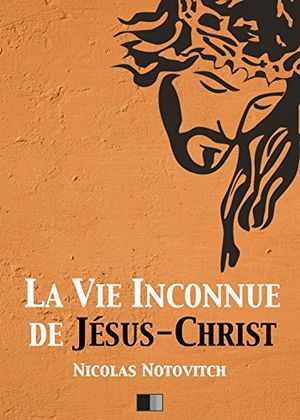La vie inconnue de Jésus-Christ (The Unknown Life of Jesus Christ / 1894 Notovitch), arch-fi book
La vie inconnue de Jésus-Christ <French> / The Unknown Life of Jesus Christ (1894) is an arch-fi book by Nicolas Notovitch.
Abstract
Not the first but the most influential piece of fantastic archaeology (or archaeological fiction) of the 19th century in the field. Russian aristocrat, war correspondent and traveler Notovitch claimed to have found written evidence of the presence of Jesus in India, prior to his ministry in Palestine. According to a manuscript he allegedly saw while visiting the Tibetan monastery of Himis in 1887 (Life of Saint Issa, the Best of the Sons of Men), Jesus spent six years among the Brahmins, then other six years among the Buddhists, before preaching to the pagans, the Zoroastrians, and the Jews. It was Pontius Pilate, who put him to death, in spite of the opposition of the Jewish Sanhedrin. Notovitch’s work was a hit, spurring large controversy. Notovitch's book inspired numerous fictional works, as well as religious movements, such as the Muslim Ahmadiyya sect. Is still very popular within New Age or Spiritualist circles. -- Gabriele Boccaccini, University of Michigan
"Jésus a-t-il passé une partie de sa vie en Inde, durant ces dix-huit années de son existence— entre 12 et 30 ans — dont la Bible ne fait aucune mention ? Si personne à ce jour n’a jamais été en capacité de vérifier les propos de l'auteur, lui qui dit avoir vu dans un monastère Bouddhiste du Ladakh des parchemins dans lesquels le passage de Jésus en Orient est clairement mentionné, il n'en reste pas moins que la thèse défendue par Notovitch reste des plus intrigantes. Car le sujet fit l'objet maintes fois de vives polémiques au point que la publication de l'ouvrage fut interdite à la fin du XIXe siècle par l'Église catholique. Faut-il dès lors y voir la volonté de cacher une vérité dérangeante ? Et si les documents cités par l'auteur étaient véritables ? Cette probabilité mérite d'autant plus d’être envisagée que d'illustres intellectuels, dont Nicolas Roerich qui fut Prix Nobel de la Paix en 1929, corroborent les propos de Notovitch et témoignent de l’existence de ces fameux parchemins. On imagine avec aisance les implications qu'une telle découverte pourraient avoir."--Publisher description <French>
Editions
Published in Paris [France]: Ollendorff, 1894. At least eight editions of it were printed that year.
Translations
Three separate American translations were copyrighted in 1894: on May 4, that of F. Marion Crawford, published by Macmillan; on May 18, that of J. H. Connelly and L. Landsberg, published by G. W. Dillingham, in New York; and on May 28, that of Alexina Loranger, published by Rand, McNally & Co., of Chicago. An Italian translation by R. Giovannini appeared the same year, and a German version, Die Luecke im Leben Jesu, was printed in Stuttgart that year (The "Italian translation" by A. Giovannini -- often referred to in bibliographies -- is in reality a book of criticism of Notovitch published in 1894 in French by the secretary of the Nunziatura Apostolica of Lisbon, Portugal). A London translation, by Violet Crispe, published by Hutchinson, appeared in 1895. The Dillingham book in 1926 was republished in New York by R. F. Fenno, but with copyright dated 1890! A Spanish version by A. G. de Araujo Jorge appeared in Rio de Janeiro in 1909. The Italian translation was eventually published in 2000
Also in Spanish; see (1909 Notovitch / Araujo), arch-fi book (Argentine-Spanish ed.)
